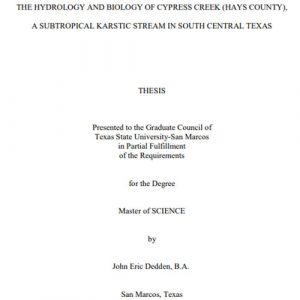Hydrology and Biology of Cypress Creek (Hays County)

This study describes the fish and benthic macroinvertebrate communities of the spring-fed Cypress Creek (Hays County). Jacob’s Well is a karstic spring which discharges into Cypress Creek approximately 5 km northwest of Wimberley in westcentral Hays County (at 30°02′ N, 8°08′ W), and is the primary spring source of water to the creek. The well issues from an inclined shaft 40 m deep from what is thought to be the most extensive underwater cave in Texas, along a fault line within the Edward‘s Plateau. The creek flows southeast for approximately 23 km into the Blanco River in Wimberley (at 29°59′ N, 98°06′ W). Its flow is perennial only in the lower 23 km, where spring flows from the Trinity Aquifer at Jacobs Well sustain stream flow. The Cypress Creek watershed drains 122.3 km2 of agricultural and residential lands including developed areas such as Woodcreek and Wimberley. Cypress Creek (classified as Segment 1815 by the Texas Commission on Environmental Quality (TCEQ), enters the Blanco River at Wimberley. The Blanco River is 140 km in length, drains a watershed of 1,067 km2, and is considered a priority conservation area according to The Nature Conservancy of Texas ecoregional planning exercise for the Edwards Plateau (Jester et al. 2007).
Historical records indicate that Jacob‘s Well once propelled water 2 m into the air. However, in recent years, changes in the usual flow regime have been observed. During the period between July and September 2000, Jacob‘s Well stopped flowing for the first time in recorded history. During this study, streamflow measurements ranged from 1.4 m3/s during early March, to 0.06 m3/s during the late summer and fall—no streamflow was observed at the most upstream sites in Cypress Creek during this period of drought. Twenty-one fish species and 31 benthic macroinvertebrate taxa were collected, and indices of biological and habitat quality indicated ―high‖ (but not exceptional) water quality.
Maintaining a natural flow regime is important for sustaining the ecological integrity of flowing water systems. Native plant and animal species have adapted to natural patterns of water flow to survive and reproduce. Although flow regime alteration (as a result of aquifer pumping, channelization, dams, and other human modifications) may be advantageous for some exotic and predator species, changing the natural flow regime generally is detrimental to native fish species, particularly sensitive species. Major alterations in rivers and streams may also lead to changes in species abundance and composition. These alterations can affect the overall health of the ecosystem. Aquatic ecosystems subject to extremes in flooding and drought cycles may affect fish assemblage composition by selecting for disturbance tolerant fish, while habitat variability (i.e. habitat complexity) can decrease the effect of this disturbance by providing refugia.
Four sites along Cypress Creek were sampled for fish by seining and backpack electrofishing. Benthic macroinvertebrates were sampled simultaneously using a Dframe kicknet. Habitat variables were measured at each site to determine the relationship between stream discharge, habitat variability and fish and benthic macroinvertebrate assemblage structure. Preliminary findings indicate the fish and macroinvertebrates of Cypress Creek are well adapted to the natural flow regime, however, fish and macroinvertebrate indices of biotic integrity (IBIs) showed lower scores than the exceptional aquatic life designation for Segment 1815 Cypress Creek (TCEQ 1999).